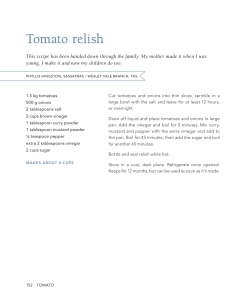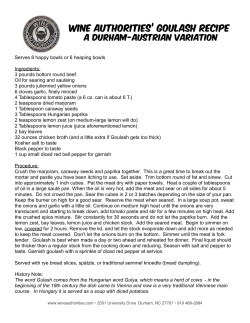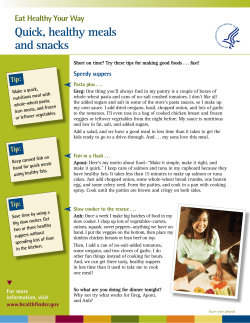
Market Thymes
Market Thymes A Publication of Pacific Coast Farmers’ Market Association November 2013 A Fresh & Local Thanksgiving In this Issue Glorious Onions The Magic of Mirepoix Sweet Potatoes Fresh Thanksgiving Recipes Cookin' the Market with Anna Buss What's in Season Staff Profile - Ben Palazzolo Thanksgiving is a great time to eat locally. Many people have always eaten locally and in season at Thanksgiving without even knowing it. Squash and sweet potato dishes, pumpkin and apple pie, and other traditional family recipes are usually locally grown and obviously in season. We know that eating locally and sustainably supports the local economy because it supports local farms and farmers, because it's easier on the earth, and because it supports responsible development. This holiday season, pledge to purchase and add at least one locally grown, raised, or produced item to your Thanksgiving menu. There are turkeys locally raised in Napa and other Bay Area locations. Winter squash, pumpkins, and other local vegetables and fruits are available at your farmers' market, and even locally grown flowers are here to decorate your festive holiday table. And of course, there are local wines and brews to enjoy! Take the "eat local challenge" this holiday season and support local farms and food producers, ranchers, nurseries, shops, and your local community. It's easier-and tastier-than you think. Happy Thanksgiving to you and yours! Produce Crate Label, Pilgrim Brand Oranges, Highland, California. Pacific Coast Farmers’ Market Association Our mission is to establish and operate community supported certified farmers’ markets and other direct marketing outlets that provide: viable economic opportunities for California farmers and food producers, local access to farm fresh products, support for local businesses and community organizations, and education concerning food, nutrition and the sustainability of California agriculture. Photo: Yellow Onions, Happy Boy Farms, San Mateo Farmers' Market. Onions! Glorious Onions! "Banish (the onion) from the kitchen and the pleasure flies with it. Its presence lends color and enchantment to the most modest dish; its absence reduces the rarest delicacy to hopeless insipidity, and dinner to despair." Elizabeth Robbins Pennell, American columnist. Cooking would not be the same without onions! This simple bulb is not only versatile and flavorful, but they’re also good for us. They are low in calories, and are purported to have antibacterial qualities. Red Onions: About 8% of the U.S. onion crop is red. They have gained popularity in the past decade because of their color and their mild sweet flavor. The first Pilgrims brought onions with them on the Mayflower. However, they found that strains of wild onions already grew throughout North America. Native Americans used wild onions in a variety of ways, eating them raw or cooked, as a seasoning or as a vegetable. According to diaries of colonists, bulb onions were planted as soon as the Pilgrims could clear the land. White Onions: About 5% of U.S. onion production is dedicated to white onions. They are commonly used in white sauces, potato and pasta salads, and in Mexican or Southwest cuisine. Due to the compact nature of their cell structure, white onions do not store quite as long as others. Flavor is mild and sweet. Yellow Onions: Allpurpose and most popular, approximately 87% of the U.S. onion crop is comprised of yellow varieties. The most well-known sweet onions are yellow. The best type of onion for caramelizing is a yellow storage variety. Cooking brings out this variety's nutty, mellow, often sweet, quality when caramelized. Green Onions: Green onions are young shoots of bulb onions, and are milder tasting than large bulb onions. They have a small, not fully developed white bulb end with long green stalks. Both parts are edible. Scallions are considered younger than a green onion because they should not have a bulb, while green onions should have a miniature bulb. Shallots: Shallots are members of the onion family, but are formed more like garlic than onions. Shallots are favored for their mild onion flavor, and can be used in the same manner as onions. A shallot looks like a small, elongated onion with a copper, reddish skin. When peeled, shallots separate into cloves like garlic. The Magic of Mirepoix A mirepoix (pronounced MEER PWAH) or "trinity" of carrots, celery, and onions are the essentials of many recipes like stocks, sauces, soups, and stews. The flavor it imparts is almost magical! These three ingredients are commonly referred to as aromatics. Similar such combinations, both in and out of the French culinary repertoire, sometimes include leeks, parsnips, garlic, tomatoes, shallots, mushrooms, bell peppers, chilies, and ginger. In Cajun cuisine, a mirepoix or trinity is a combination of onions, celery and bell peppers. Mirepoix is usually diced in recipes and the proportions (by weight) for making it are 50% onions, 25% carrots and 25% celery. Sautéed with a little olive oil or butter, the flavors seep into your recipes and add depth to any dish. Add to your Thanksgiving stuffing recipe! Mirepoix Vegetable Stock 1 cup diced carrots 1 cup diced celery 2 cups white or yellow onions 3 tablespoons salt 1/4 teaspoon ground black pepper 2 to 3 tablespoons olive oil 5 quarts water Fresh herbs such as rosemary, thyme, bay leaf, etc. Heat oil in a soup pot. Add onions, celery, carrots, and herbs. Cook over high heat for 5 to 10 minutes, stirring frequently. Add salt and water and bring to a boil. Lower heat and simmer, uncovered, for 30 minutes. Strain. Discard vegetables. Use stock in soups, stews, or other recipes. Cookin' the Market with Chef Anna Buss Okinawan/Ubi (Purple Sweet Potato) Thanksgiving is a time for comfort and tradition, which in my home means gathering together with family and eating foods that are heavy, rich, and warm. As a kid I would get excited about my aunt’s famous sweet potato casserole topped with marshmallows or my cousin’s creamy spinach dish. And as I look forward to these food keepsakes, I get even more excited when someone brings something new to the table. Now that I live in California and work at the farmers’ markets, I have realized there are so many different varieties within each family of produce. I get excited about incorporating new colors and textures into my meals knowing that I will be creating a dish with great flavor and nutrition. Fresh Thanksgiving Recipes Mashed Sweet Potatoes Brussels Sprouts with Onions and Almonds 5 or 6 large sweet potatoes (peeled) 1/2 cup butter (one stick) 1/2 teaspoon salt 1/4 teaspoon pepper 1 tablespoon maple syrup, more or less to taste 1 pound Brussels sprouts 4 to 6 tablespoons butter 1/2 onion (chopped) Salt and pepper 1 teaspoon lemon juice 1/4 cup almonds, slivered, toasted Peel potatoes and cut into quarters. Simmer in a large 3 to 4 quart pot of water with 2 teaspoons salt added to the water. After 20 minutes or so, test potatoes with a fork to see if they are fully tender. When cooked, drain water and return sweet potatoes to pan over stillwarm burner (leave burner off or on very low heat). Boil in water or steam Brussels sprouts for 3 to 4 minutes until just tender. Strain and place in a bowl of ice water to keep the color bright green. Cut into halves. Add butter to bottom of pan and stir until melted. Using a potato masher, mash the sweet potatoes with the butter, adding salt and pepper, to taste. Add maple syrup to sweeten, stirring thoroughly. Recipe: PCFMA Staff. Sauté onions in 2 to 3 tablespoons of butter in a sauté pan until the onions are translucent. Add the Brussels sprout halves and 2 to 3 tablespoons more butter and cook on medium high heat for several more minutes, until the sprouts have reached your desired level of doneness. Do not over-cook, or sprouts will become bitter. Add salt and pepper to taste while sprouts are cooking. One variety that always jumps out at me during the fall markets is Remove from heat, toss in the Okinawan sweet potato, also half of the toasted slivered known as ubi. The beautiful purple almonds and the lemon hue shows it has a high level of juice. Add salt and pepper if antioxidants, which needed. Put into serving dish will help keep the and garnish with the rest of immune system the toasted almonds. strong during the Recipe: a2zrecipes.com. flu season. Ubi is also a good source of copper, fiber, vitamin B6, Sweet Potatoes vs. Yams potassium, and iron. Before you reach for the yams this Thanksgiving, there's something you need to know. They're not actually yams! All this time, many Americans have been making the mistake People covet it for its sweet of calling sweet potatoes "yams." But there's a difference. It turns out sweet potatoes flavor and creamy texture. It and yams are not even related. They are two different species of root vegetable with can be made into a striking very different backgrounds and uses. purple dessert such as a cake, pie or ice cream. It can Sweet potatoes (Ipomoea batatas) come in two main varieties here in the States. One has a golden skin with creamy white flesh and a crumbly texture. The other has a also be roasted, steamed, copper skin with an orange flesh that is sweet and soft. Since there are two types of mashed, or simmered in a sweet potatoes, one with creamy white flesh and one with orange, the USDA labels the savory dish. So this year orange-fleshed ones "yams" to distinguish them from the paler variety. Within this sweet why not put a spin one of potato category are several flavorful varieties seen at your farmers' market. your favorite traditional dishes. Surprise, engage, Yams (family Dioscoreaceae) are native to Africa and Asia and other tropical regions. and educate your family by Yams are starchy tubers that have an almost black bark-like skin and white, purple or introducing news colors, textures, and flavors to your reddish flesh and come in many varieties. These are usually imported to the U.S. from Caribbean nations. Thanksgiving repertoire. Pacific Coast Farmers’ Market Association 5060 Commercial Circle, Suite A Concord, CA 94520 925.825.9090, Fax 925.825.9101 www.pcfma.com Board of Directors Narsai David President Emeritus Patrick Fabian President Albert Terry Vice President Mike Billigmeier Secretary Leonard Conniff Treasurer John Paul Barbagelata Al Courchesne Steve Fernandes Shelly McMahon Les Portello Phil Rhodes PCFMA Staff John Silveira, Director Lauren Beal Cody Brooks Anna Buss Laura deTar Thomas Dorn Jessica Echols Stephanie Hadsell Mario Hernandez Maureen Hovda Ron Jackson Jeff Jelsma Jacqueline Kidd Caroline King Pat Lane Shawn Lipetzky Minnie Low AJ Mahon Maureen McCloskey Moises Mena Jessica Millender Debra Morris Allen Moy Tom Nichol Anne O’Leary Ben Palazzolo Tomas Pascual Michael Peterson Sameer Poudyal Greg Pursley Leah Ricci Stefan Robinson Laura Salcido Matt Sylvester Chong Thao Max Timms Kelly Toomey Ramiro Tovar Sarah Trent Ron Ulrici Jorge Vega Keith Wall Ashley Weidman Eric Winkler Greg Zeroun Editor: Debra J. Morris Comments, suggestions: mrcarrot@pcfma.com Staff Profile Ben Palazzolo, Regional Manager Ben has been a part of PCFMA since April 2011. At that time, he was hired as a Market Manager. After managing several markets he was promoted to Regional Manager in January 2013, overseeing markets in Santa Clara County. He says, “Food has always occupied an important place in my life. Growing up I was very fortunate that both my parents cooked most of our meals from scratch. They both placed a high value on food, as a source of nutrition and as a means of connecting with family and friends. I like to consider myself a passable cook, although I haven’t spent as much time cooking during the last few years as I would like.” Besides cooking at home, he tries to spend time outdoors enjoying nature, hiking or camping. He recently camped in King’s Canyon, and has spent time during the last several months exploring the many beautiful trails within the East Bay Regional Park District. “I use my bicycle as often as I can to get to and from our office in Concord or to explore my own neighborhood. I installed collapsible panniers on my bike so I can use it for errands as well. My philosophy is that the less time I spend in a car in the Bay Area, the happier I’ll be. Besides bicycling, I was practicing Tai Chi in Pleasant Hill with the Taoist Tai Chi Society of America for over a year. I enjoy going out to dance the salsa, too,” he says. By coincidence, a half a dozen friends that he lived with during college have moved to the Bay Area over the last several years. Most of them he's known for over ten years. He says he's very grateful to have old friends close by in an area he is relatively new to, having moved to the Bay Area from San Luis Obispo about three-and-a-half years ago. Recently, he's had the joy of participating in several of their weddings and officiated at the wedding of close friends. Lastly, he loves fixing up his apartment in the colorful little neighborhood surrounding Piedmont Avenue. Antique shops, thrift stores, and plant nurseries abound in Oakland and the East Bay. "I strive to accomplish something in my home each day, even if it's just hanging a picture by the front door," Ben says. In Season Fruit: Many varieties of figs and grapes will be available through the fall. Also here are pears, apples and little jujubees. Persimmons and pomegranates make their appearance. Vegetables: Artichokes, Brussels sprouts, sweet potatoes, parsnips, carrots, onions, and potatoes are here. Try must-have gorgeous winter squash. Year-round favorites include spinach, chard, kale, broccoli, radishes, cabbage, beets, carrots, celery, and all kinds of leafy greens. Asian greens and herbs are still available. And don’t forget mushrooms and garlic! Check out the amazing fall flowers! Chrysanthemums, asters, goldenrod, snapdragons, daisies, coneflowers, and filler greens like eucalyptus and ferns. Look for citrus and kiwifruit soon. And pick up olive oil, cheeses, and dried fruits and nuts for the holidays.
© Copyright 2025











